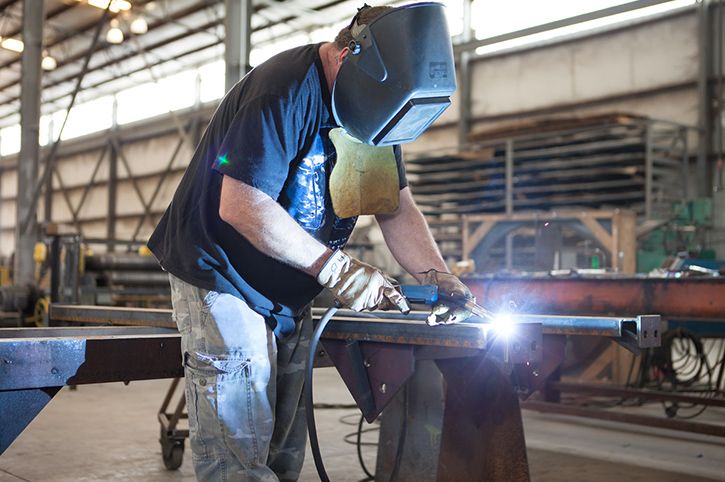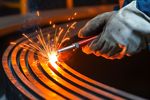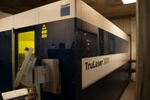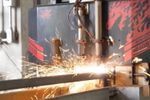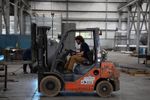It only takes one welding mistake to weaken a critical component of an industrial staircase or bulk storage system. But a quality-controlled welding station can ensure the structural integrity and long-term value of each metal fabrication. Before partnering with a metal fabricator, it is important to ask for documentation to assess if the vendor’s welding station meets quality control (QC) and industry standards.
Here are some of the essentials of a quality-controlled welding station.
Select the Right Welders for Assembly
A full-service metal fabricator should have multiple types of metal welding equipment and machinery for welding assembly. While certain welders are appropriate for repairs, it takes a wide array of machinery for ensuring QC-controlled assembly.
This machinery lineup should include:
- Stud Welders: A fully-equipped welding station should include at least two stud welders with capacities up to 7/8″ diameter.
- MIG Welders: Full-service fabricators may have more than 20 of these machines in their welding station, with capacities to 450 amp.
- TIG Welders: Multiple TIG welders should be available with capacities up to 300 amp.
- Portable Welders: The welding station should also house multiple portable welders with capacities up to 250 amp.
This equipment portfolio should also include OTC welding machines that provide a constant power output to prevent spatter, unlike more traditional MIG machines with inconsistent power outputs. Preventing spatter is not only important for quality control, but for safeguarding welders from burns.
Follow Spatter Prevention Best Practices
Protecting welders from spatter and burns is essential to welding quality control, as even a minor accident can result in a serious welding error that can compromise a metal fabrication’s structural integrity.
Spatter occurs from working with metals of different thickness or from incorrect welding settings, such as setting the voltage or amperage too high. Dangerously hot spatter can reach up to 35 feet from any welding area, placing employees at risk for burns, eye injuries, and spark-fire hazards.
Experienced metal fabricators prevent spatter by:
- Selecting quality welding wire appropriate for each fabrication.
- Using correct gas mixtures for each type of weld.
- Eliminating poor surface conditions, such as oily parts, rust, etc.
- Applying proper torch angles and correct wire stick-out lengths.
- Checking for grounding when selecting a welding location.
Know How Safety Impacts Welding Quality
Following critical safety protocols during welding and assembly is key to controlling production costs and creating higher quality results. Full-service metal fabricators understand the ROI of protecting their most important long-term assets: their employees.
Welding stainless steel, nonferrous chromium alloys, or similar “hot work” can release hexavalent chromium and other toxins that can easily be inhaled through the nose or mouth, and can target the respiratory system.
Without safety protocols, welders are at risk for:
- Spatter or spark burns on exposed, unprotected skin.
- Cutting mishaps due to limited visibility from weld smoke.
- Rashes or skin ulcers from hexavalent chromium exposure.
- Nosebleeds, sores, or even perforations in the nasal septum.
- Asthma or lung cancer from long-term weld smoke exposure.
Worse yet, combustible gases can build up in feed welds, where just a single spark can ignite an explosion and endanger the entire shop floor. Even minor welding injuries can devastate productivity, derail fabrication deadlines, and invite OSHA fines. Implementing safety-driven QC early in the process prevents mistakes and avoids costly downtime and material handling expenses.
Ensure Safety-Driven Quality Control
Welding safety begins with a QC program that focuses on education, especially when it comes to material handling and equipment operation. A reputable metal fabricator will include welding training as part of their safety-driven quality control program.
This training may include:
- Properly using PPE, such as 3M masks with welder hoods.
- Protecting against falling objects (welder helmets obscure vision that prevents the worker from noticing a falling object).
- Checking welding aprons, gloves, or other protective clothing for tears or holes that can leave skin exposed.
- Inspecting goggles and face shields for scratches that impair visibility.
- Selecting proper welding equipment that should only be used after equipment protocol training is complete.
- Partner With a Metal Fabricator Well-Versed in Quality Control
Following safety-driven welding procedures can ensure each metal fabrication meets specific industry standards. That is why Southern Metal Fabricators only employs certified welders as part of our documented QC program.
But welding is only part of the quality equation. From regularly updating our QC manual in accordance with industry standards, to innovating new ways to improve our QC procedures, quality control is integral to how we approach every custom project.
These best practices minimize liability and risk. Our documented QC system can prevent mistakes before they occur, ensuring ROI and helping our customers protect their operations and reputation.
If you’re ready to partner with a true full-service fabricator who can help you meet and exceed quality control expectations, give us a chance to say, “Yes, we can do that!” by contacting us today.
